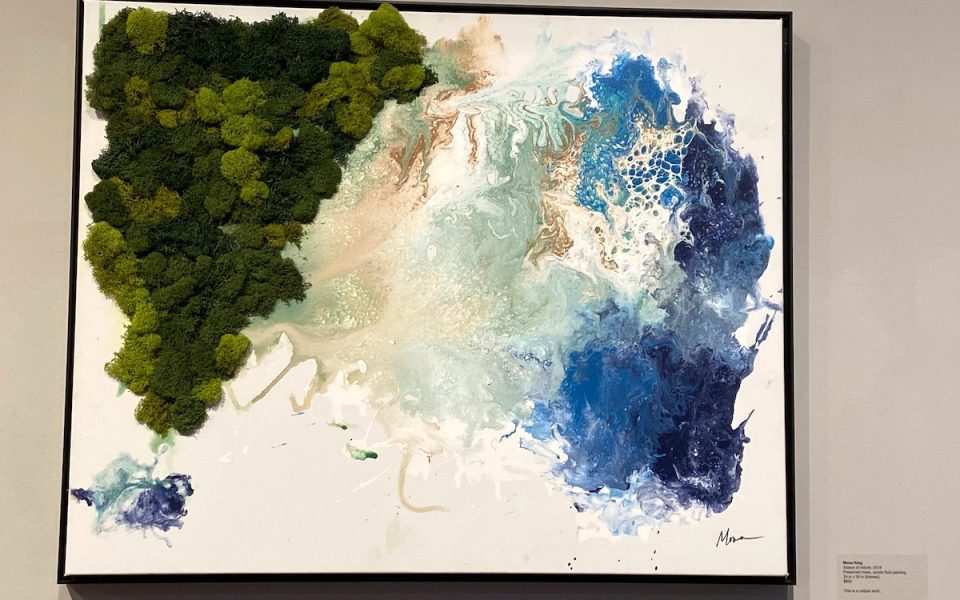Dense, green clumps of moss covers the
rectangular canvas, an abundant assembly of greenery, clustered tightly together
with a deep-blue, acrylic path weaving down the middle of the piece, like a
river. This tropical landscape is titled “The Amazon,” and gives observers a
bird’s eye view of the largest rainforest in Brazil.
Just in front of the moss-covered artwork,
sporting a pair of rectangular shaped lenses, stands Mona King — an artist and
a graduate from UNCG’s Interior Architecture program. “The Amazon” is just one
of a variety of artwork created with different media and resources found in the
environment.
“I grew up with a house full of plants and flowers,”
King says. “My mother had a green thumb. We had this one section of the living
room that was just filled with plants from floor to ceiling. We weren’t
supposed to be in the living room as it was only for guests, but that’s where
you would go when you wanted to feel good or warm. As it just kind of enveloped
you.
“Nature has a way of connecting the human spirit to make us feel safe and comfortable,” she concludes.
King’s new art show “Living Aura” is on display at the Revolution Mill in Greensboro and opened in January. The show will be available until March 13.
Each moss collage has not only this flowerless greenery, but a mixture of other plants as well. In one landscape, King uses bamboo and scabiosa — a lilac-colored flower native to Africa, Europe and Asia — to create a jungle image.
“Somebody wrote me a letter asking why I am
taking all the moss, as it’s natural,” she says. “Mine is sustainably harvested
and usually not from the United States. So, they make sure that if they are
removing the moss that it does have the ability to grow back. So, I have to use
multiple sources from all over the world.”
Gazing up at the overhead architectural model-like
image, she talks about the subtle messages that can be seen in her works.
“I have a member of an advisory team and he came
into one of my first showings and he says, ‘I love what you’re doing, but your
work also has to relay a message to people,’” she says. “I created the one that
is a tribute to the Amazon to bring awareness of what’s going on in our world
and our climate. This may be something you won’t see 10 years from now, because
there won’t be any trees. Again, I’m thinking about what’s now happening to
Australia, California and climates around the world.”
Gesturing towards the piece again, King speaks further
on the piece and its importance.
“The rainforest is like a lung that cleans the
air,” she says, “and that it is actually a breathing system that is from the
trees. People don’t realize that.
“It purifies, it cleanses the air and provides
moisture into the atmosphere,” she contiues. “And as we destroy more trees, we’re
losing that.”

On the other side of the room, two more images
splayed on two canvases hang side by side. Both works feature a photograph of
the base of a tree mixed with brown leaves, twigs, stones and green moss in the
background. It looks as though the objects in the photograph are breaking out
of the canvas and into the real world.
“It’s kind of like when you’re in a theater performance, and there’s 20 things going on and you can’t see which way to look,” King says. “There’s always something different. I don’t want it to be one big, green mass of moss or one stick or leaf. I want you to be able to explore and find something different.”
Three visitors enter the exhibit, pausing
mid-step to catch glimpses of the large, framed artwork depicting tones of
light and dark green chunks of moss bundled together. One woman in the group
wearing a small winter hat on her head stare at the landscape intensely, drawn
to the mix of green moss and oceanic blues in the bottom left of the frame.
“I just hope people have an open mind to
different types of art,” King says. “Everybody thinks the traditional painting,
sketching or drawing — this is different because it combines all those elements
but it’s kind of combination of photography, sculptor, collage and imagination.
If you look at a picture and see a beach, other people may see other things.”
Turning her head to the sound of voices coming
from a man and a woman entering the exhibit, she says, “I hope that they see the value and that it
will calm you —and that it will have a long-lasting value, then just I need to
put something on the wall.”
Ramona King’s exhibition will be on display at Revolution Mill through March 13. Learn more at livingaura.design.
Join the First Amendment Society, a membership that goes directly to funding TCB‘s newsroom.
We believe that reporting can save the world.
The TCB First Amendment Society recognizes the vital role of a free, unfettered press with a bundling of local experiences designed to build community, and unique engagements with our newsroom that will help you understand, and shape, local journalism’s critical role in uplifting the people in our cities.
All revenue goes directly into the newsroom as reporters’ salaries and freelance commissions.


Thank you Rachel for capturing the intent of my art. I am looking forward to reading more of your work in the future. Mona King
Thank you Mona.
-Rachel